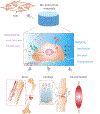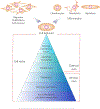Bio-instructive materials for musculoskeletal regeneration
- PMID: 31302298
- PMCID: PMC6717669
- DOI: 10.1016/j.actbio.2019.07.014
Bio-instructive materials for musculoskeletal regeneration
Abstract
The prevalence and cost of disorders affecting the musculoskeletal system are predicted to rise significantly in the coming years due to the aging global population and the increase of associated risk factors. Despite being the second largest cause of disability, the clinical options for therapeutic intervention remain limited. The clinical translation of cell-based therapies for the treatment of musculoskeletal disorders faces many challenges including maintenance of cell survival in the harsh in vivo environment and the lack of control over regulating cell phenotype upon implantation. In order to address these challenges, the development of bio-instructive materials to modulate cell behavior has taken center stage as a strategy to increase the therapeutic potential of various cell populations. However, the determination of the necessary cues for a specific application and how these signals should be presented from a biomaterial remains elusive. This review highlights recent biochemical and physical strategies used to engineer bio-instructive materials for the repair of musculoskeletal tissues. There is a particular emphasis on emerging efforts such as the engineering of immunomodulatory and antibacterial materials, as well as the incorporation of these strategies into biofabrication and organ-on-a-chip approaches. STATEMENT OF SIGNIFICANCE: Disorders affecting the musculoskeletal system affect individuals across the lifespan and have a profound effect on mobility and quality of life. While small defects in many tissues can heal successfully, larger defects are often unable to heal or instead heal with inferior quality fibrous tissue and require clinical intervention. Cell-based therapies are a promising option for clinical translation, yet challenges related to maintaining cell survival and instructing cell phenotype upon implantation have limited the success of this approach. Bio-instructive materials provide an exciting opportunity to modulate cell behavior and enhance the efficacy of cell-based approaches for musculoskeletal repair. However, the identification of critical instructive cues and how to present these stimuli is a focus of intense investigation. This review highlights recent biochemical and physical strategies used to engineer bio-instructive materials for the repair of musculoskeletal tissues, while also considering exciting progress in the engineering of immunomodulatory and antibacterial materials.
Keywords: Biomineralization; Electroconductive; Musculoskeletal; Stem cell differentiation; Tissue engineering.
Copyright © 2019 Acta Materialia Inc. Published by Elsevier Ltd. All rights reserved.
Figures





References
-
- Yelin E, Weinstein S, King T, The burden of musculoskeletal diseases in the United States, Semin. Arthritis Rheum 46 (2016) 259–260. - PubMed
-
- Atala A, Lanza R, Thomson JA, Nerem RM, Principles of regenerative medicine, 2008.
-
- Custódio CA, Reis RL, Mano JF, Engineering biomolecular microenvironments for cell instructive biomaterials, Adv. Healthc. Mater 3 (2014) 797–810. - PubMed
Publication types
MeSH terms
Substances
Grants and funding
LinkOut - more resources
Full Text Sources
Other Literature Sources
Research Materials

